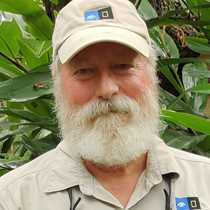At Sea in the Drake Passage
Our day aboard the National Geographic Endeavour was something everyone has been apprehensive about for quite some time…that is, the crossing of the infamous Drake Passage. Even when most of us gathered at the Hyatt Hotel in Santiago, Chile, a couple days ago, people were concerned about what they would encounter today. We were lucky. In fact, I can’t remember when we’ve enjoyed such a day with a bright blue sky and light winds in this part of the Southern Ocean. There was just enough of a smooth, long swell to gently let us know we really were at sea.
It was the perfect day to recuperate from several days of intense travel spent making our way to the southern-most reaches of South America, where we boarded the ship. This morning, we met the natural history staff and photographers who will accompany us on this voyage, and this was followed by Richard White giving us a very interesting and appropriate talk about the Southern Ocean sea birds.
The bird watchers on board, which includes virtually everyone (although some are more serious than others), were thrilled with the antics of wandering albatrosses as they followed, circled, and shadowed the ship throughout the day. There were those among us who spent nearly the entire day out on the Bridge Wing with their binoculars glued to their eyeballs. Of course, we spotted numerous other interesting species of sea birds near the ship, as well as several glimpses of beaked whales and a few very distant blows from unidentified big baleen whales.
In the afternoon, Eduardo Shaw told us the fascinating story of how the ancients surmised there must be a huge unknown southern land (Terra Australis Incognita) to offset the known land masses in the Northern Hemisphere. Otherwise, they reasoned, the world would not rotate properly on its axis, but would wobble. In spite of numerous attempts by many explorers up to and including James Cook, it was not found. Think about it…this system of exploration was opposite to the norm, meaning the Great Southern Continent was placed on maps before it was actually known and explorers through time then showed where it didn’t exist. Well, there is a southern continent as we all know, but it isn’t as large as was once thought. We will encounter it pretty soon, if all goes according to plan.
This evening, Captain Philipp Dieckmann officially welcomed everyone aboard the ship, our home for the next three weeks or so, and introduced his senior officers. Yes, we were off to a great start on our epic voyage.
Our day aboard the National Geographic Endeavour was something everyone has been apprehensive about for quite some time…that is, the crossing of the infamous Drake Passage. Even when most of us gathered at the Hyatt Hotel in Santiago, Chile, a couple days ago, people were concerned about what they would encounter today. We were lucky. In fact, I can’t remember when we’ve enjoyed such a day with a bright blue sky and light winds in this part of the Southern Ocean. There was just enough of a smooth, long swell to gently let us know we really were at sea.
It was the perfect day to recuperate from several days of intense travel spent making our way to the southern-most reaches of South America, where we boarded the ship. This morning, we met the natural history staff and photographers who will accompany us on this voyage, and this was followed by Richard White giving us a very interesting and appropriate talk about the Southern Ocean sea birds.
The bird watchers on board, which includes virtually everyone (although some are more serious than others), were thrilled with the antics of wandering albatrosses as they followed, circled, and shadowed the ship throughout the day. There were those among us who spent nearly the entire day out on the Bridge Wing with their binoculars glued to their eyeballs. Of course, we spotted numerous other interesting species of sea birds near the ship, as well as several glimpses of beaked whales and a few very distant blows from unidentified big baleen whales.
In the afternoon, Eduardo Shaw told us the fascinating story of how the ancients surmised there must be a huge unknown southern land (Terra Australis Incognita) to offset the known land masses in the Northern Hemisphere. Otherwise, they reasoned, the world would not rotate properly on its axis, but would wobble. In spite of numerous attempts by many explorers up to and including James Cook, it was not found. Think about it…this system of exploration was opposite to the norm, meaning the Great Southern Continent was placed on maps before it was actually known and explorers through time then showed where it didn’t exist. Well, there is a southern continent as we all know, but it isn’t as large as was once thought. We will encounter it pretty soon, if all goes according to plan.
This evening, Captain Philipp Dieckmann officially welcomed everyone aboard the ship, our home for the next three weeks or so, and introduced his senior officers. Yes, we were off to a great start on our epic voyage.



